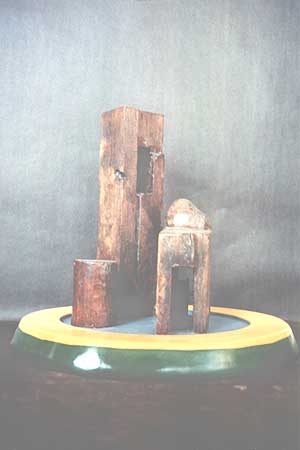
| left view | | top view |
Acequia
1996
Maquette
H16" x W10"
Mixed Media
Acequia is a Moorish concept. It was assimilated by the Spanish and later introduced
into the South West. It means, 'transferance of water'. When the Moors occupied Spain,
they improved and expanded water delivery systems. Later, when the Hispanic emigres
settled the high desert of the south western US, they melded their knowledge of the acequia
with the simple and efficient water collection of the Pueblo occupants.
As the Hispanic population increased, both the natural and man made water systems were shared
and expanded. As a result, large extended families grew into rural communites who devised
systems to distribute scarce and seasonal water for personal and agricultural use. Land
situated away from the banks of flowing streams, wells or ponds were supplied by a series
of ditches, dams and flumes (viaducts).
Rules were established for fair distribution of the water. Simple political systems
evolved to administer the local laws. 'Parciantes' or those who participated in the
usage and maintenace of the acequia water system elected administrative representatives
who appointed a majordomo to police and protect. It is a simple and local system of
direct democracy of domestic common law.
In the early 1900's, New Mexico recognized these Acequia Water Laws by enshrining them
within the State Water Laws. Prior rights or priority and eminent domain or superior dominion
protect ancient acequias. These laws have never been abrogated nor are there laws of the
county, the state or the federal government which supersede these old water laws. So that,
a simple, local and direct democracy still exists today.
In real terms, what this means is: that, if a proposed development in the lands supporting
an ancient acequia has been successful in complying with all governmental codes and regulations,
the developer must then defer to the acequia association to get permission to disturb or cross
the acequia. If the Majordomo vetoes the project, that is the end of the proposed development.
Of note is the fact that an acequia is not a real entity in the sense of a car, house or
property but exists as a real system of people and their lands, works, and laws for the usage
and maintenance of the transference of water.
Three simple, but different shapes are arranged so as to evoke the spirit of the acequia.
The tall monolith is the progress aspect. The short cylinder is the torreon or watch tower.
And the box with the round head represents the 'Gente' or the people. Blue is the water,
yellow is the corn and the green is the land.
This piece, like 'Horno', was entered as a maquette for some public art competitions in the
Southwest. The sculptural idea works well when rendered in life size or as a larger monumental
approach.
The wood is from scraps of mesquite doors from Panama. During a stint at the La Puerta
door factory in Santa Fe, the artist collected these pieces destined for the dump. They
can be seen in other works: Horno,
One Night in Baghdad, and Those Before.
As the Hispanic population increased, both the natural and man made water systems were shared and expanded. As a result, large extended families grew into rural communites who devised systems to distribute scarce and seasonal water for personal and agricultural use. Land situated away from the banks of flowing streams, wells or ponds were supplied by a series of ditches, dams and flumes (viaducts).
Rules were established for fair distribution of the water. Simple political systems evolved to administer the local laws. 'Parciantes' or those who participated in the usage and maintenace of the acequia water system elected administrative representatives who appointed a majordomo to police and protect. It is a simple and local system of direct democracy of domestic common law.
In the early 1900's, New Mexico recognized these Acequia Water Laws by enshrining them within the State Water Laws. Prior rights or priority and eminent domain or superior dominion protect ancient acequias. These laws have never been abrogated nor are there laws of the county, the state or the federal government which supersede these old water laws. So that, a simple, local and direct democracy still exists today.
In real terms, what this means is: that, if a proposed development in the lands supporting an ancient acequia has been successful in complying with all governmental codes and regulations, the developer must then defer to the acequia association to get permission to disturb or cross the acequia. If the Majordomo vetoes the project, that is the end of the proposed development.
Of note is the fact that an acequia is not a real entity in the sense of a car, house or property but exists as a real system of people and their lands, works, and laws for the usage and maintenance of the transference of water.
Three simple, but different shapes are arranged so as to evoke the spirit of the acequia. The tall monolith is the progress aspect. The short cylinder is the torreon or watch tower. And the box with the round head represents the 'Gente' or the people. Blue is the water, yellow is the corn and the green is the land.
This piece, like 'Horno', was entered as a maquette for some public art competitions in the Southwest. The sculptural idea works well when rendered in life size or as a larger monumental approach.
The wood is from scraps of mesquite doors from Panama. During a stint at the La Puerta door factory in Santa Fe, the artist collected these pieces destined for the dump. They can be seen in other works: Horno, One Night in Baghdad, and Those Before.
Peter Cooke * 1233 Mount Maxwell Road * Salt Spring Island, BC V8K 2H7 * (250) 537-4617
Back to: Main Page Site by:BookBill